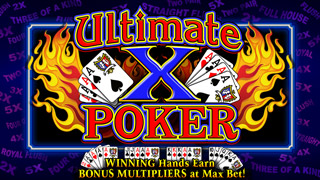Offer to Fa La La La La.... La la la la: Results (5th card flip)
-
New2vp
- Video Poker Master
- Posts: 1879
- Joined: Mon Sep 11, 2006 4:02 am
Re: Offer to Fa La La La La.... La la la la: Results (5th card flip)
new2vp that number of your odds seems a little low to me. I'm not actually calculating anything but are you sure you got the right number of zeros on there? While I think you are right that the chances might be very low, this seems a little too too low. But I'm not basing that on anything but intuition.
Eduardo, that was quite astute of you to ask if I had the correct number of zeros. I had the correct number of digits but I rounded the result to 10 significant digits because I figured most people lose interest way before 10 significant digits. This means that I did NOT have the correct number of zeros!After rechecking the odds are still really high (or the probability is still really high) at approximately 5,681,029,479,728,847,156,766,976.46944 to 1. Actually, there is only one zero in these odds! (This is extremely close to the previously quoted odds; you couldn't go wrong with either estimate.)
-
bigsteve5273@yahoo.c
- Senior Member
- Posts: 171
- Joined: Sat Oct 14, 2006 2:05 pm
My goodness, that's a lot of commas in that figure. 8 to be exact. Does that make it roughly 5 octillion?
-
New2vp
- Video Poker Master
- Posts: 1879
- Joined: Mon Sep 11, 2006 4:02 am
Actually, it's 5 septillion, give or take a few hundred sextillion. But what's a single incremental -illion among friends?Recall that a million has 2 commas, so if you want to use commas to get to the prefix, you have to subtract one.8 - 1 = "sept-"
-
cddenver
- Video Poker Master
- Posts: 2269
- Joined: Tue Mar 13, 2007 9:54 pm
The graph is in the previous message. There is no magic here except that an underlying population percentage rate of 6% generally produces samples that are near 6% and not near 40%.
Thanks for taking the time to put the WM-RS results in a graph, which makes them easier to understand. But, I just wanted to be clear...
The vertical brown line represents the observed number of flips, 11?
The blue curve shows an expected distribution of flips, assuming a 6% flip rate and a sample of 180 opportunities? So, if you repeated the test again and again with 180 opportunities each time you'd expect the observed flips to lie somewhere on that curve? The top of that curve is at (about) 12% on the vertical scale. Does that mean you'd expect about 12% of repeated tests to be close to the expected 6% flip rate?
From the graph it looks like you'd expect to see about 73 flips in a 180 opportunity test, instead of 11, if the 40% flip rate were true.
If the test had double the opportunities, 360, the curves would be taller and skinnier; if the test had half the opportunities, 90, they'd be shorter and wider, right? If that's the case, if you kept lowering the sample eventually the curves would have some overlap, but that isn't the case here, not even close to it.
The observed "flips" value is so far to the left side of that pink curve that the odds against the 40% rate being correct is that very large number you gave?
Thanks for taking the time to put the WM-RS results in a graph, which makes them easier to understand. But, I just wanted to be clear...
The vertical brown line represents the observed number of flips, 11?
The blue curve shows an expected distribution of flips, assuming a 6% flip rate and a sample of 180 opportunities? So, if you repeated the test again and again with 180 opportunities each time you'd expect the observed flips to lie somewhere on that curve? The top of that curve is at (about) 12% on the vertical scale. Does that mean you'd expect about 12% of repeated tests to be close to the expected 6% flip rate?
From the graph it looks like you'd expect to see about 73 flips in a 180 opportunity test, instead of 11, if the 40% flip rate were true.
If the test had double the opportunities, 360, the curves would be taller and skinnier; if the test had half the opportunities, 90, they'd be shorter and wider, right? If that's the case, if you kept lowering the sample eventually the curves would have some overlap, but that isn't the case here, not even close to it.
The observed "flips" value is so far to the left side of that pink curve that the odds against the 40% rate being correct is that very large number you gave?
-
cddenver
- Video Poker Master
- Posts: 2269
- Joined: Tue Mar 13, 2007 9:54 pm
There may be many other explanations for what happened...like there was never any discrepancy with non-random flipovers in the first place, but the science of statistics allows us to rule out the face-saving reason being proposed of too small of a sample. There is not a 40%+ flipover rate....unless Webman conspired with the programmers of the machines that were used. Yeah, that's probably it.
RD, in his short return visit, brought up some alternate explanations that Rob's probably considering:
1) The rigging has been removed.
2) The rigging was never widespread to begin with, occurring in some places but not others.
Rob's begun backing off his "rigging" theory. While he claims to continue to see a 40% flip rate, now it's due to regulations allowing casinos to have a certain amount of un-randomness in their machines and still call them "random". As an analogy, he wrote that companies are allowed to advertise food products as having 0% transfats even if they have up to .5% transfats (no, I'm not kidding). Still sounds like rigging to me.
Besides, everyone knows that a 40% flip rate in VP corresponds to 13.6% transfats in food. Bad analogy for him to use.
RD, in his short return visit, brought up some alternate explanations that Rob's probably considering:
1) The rigging has been removed.
2) The rigging was never widespread to begin with, occurring in some places but not others.
Rob's begun backing off his "rigging" theory. While he claims to continue to see a 40% flip rate, now it's due to regulations allowing casinos to have a certain amount of un-randomness in their machines and still call them "random". As an analogy, he wrote that companies are allowed to advertise food products as having 0% transfats even if they have up to .5% transfats (no, I'm not kidding). Still sounds like rigging to me.
Besides, everyone knows that a 40% flip rate in VP corresponds to 13.6% transfats in food. Bad analogy for him to use.
-
oej719
- Video Poker Master
- Posts: 1777
- Joined: Wed Sep 06, 2006 5:46 pm
Con men like him have no boundries. They will say anything if it will suit them and take YOUR money.
-
New2vp
- Video Poker Master
- Posts: 1879
- Joined: Mon Sep 11, 2006 4:02 am
Thanks for taking the time to put the WM-RS results in a graph, which makes them easier to understand. But, I just wanted to be clear...
The vertical brown line represents the observed number of flips, 11? YES
The blue curve shows an expected distribution of flips, assuming a 6% flip rate and a sample of 180 opportunities? YES So, if you repeated the test again and again with 180 opportunities each time you'd expect the observed flips to lie somewhere on that curve? Sure, the observed number of flips, call it x, would be between 0 and 180, inclusively. The height at each point from 0 to 180 represents the expected relative frequency of each value occurring with the numbers at high points of the graph being most likely. The combined heights of the graph at each of these 181 points will sum to 100%. When the graph is taller, those values of x are more likely; when the graph is not far from zero, it means those points are less likely to happen. What you cannot see from the graphs is how close to zero the heights really are and how ridiculously unlikely some of the points are. As you go further and further from the highest point in the graph, you get closer and closer to absolute zero (lower than the probability of hell freezing over, pigs flying, etc).The top of that curve is at (about) 12% on the vertical scale. Does that mean you'd expect about 12% of repeated tests to be close to the expected 6% flip rate? NO, the tallest point in the graph simply shows the probability of a particular value of x. If the flip rate was 6% and you performed this experiment, 12.46% of the time the result would end with 10 flips, 12.29% of the time the result would be 11 flips as occurred in the one experiment that was tried by Webman and S i n g e r. The number of flips would come out to be 9 in 11.42% of such experiments. In order to answer your question as to what % of the time the test would come out "close" to 6%, you have to define what you mean by "close." Exactly 6% would mean the value would need to be 10.8, which is impossible. The result would be within 0.8 of this number (10 or 11) about 25% of the time; the result would be within 1.8 of 10.8 (9 thru 12) 47% of the time and would be within 2.8 (8 thru 13) 66% of the time. More than 99% of the time, x will be in the range between 3 and 19. If the flip rate were 40%, 99% of the time, the number of flips observed would have been between 56 and 89.
From the graph it looks like you'd expect to see about 73 flips in a 180 opportunity test, instead of 11, if the 40% flip rate were true. Sometimes it's a bit hard to read the graphs with absolute precision, but the tallest point in the 40% flip rate curve is actually at 72 (6.06%), the 2nd tallest is at 71 (6.01%) and the third tallest occurs at 73 (5.98%). I can't really discern graphical differences such as these, so your point is correct since you said "about 73."
If the test had double the opportunities, 360, the curves would be taller and skinnier; No, the heights of the curves would actually be shorter as it would be more likely to have different values of x. For example, with a million opportuntities and a 6% rate, you could probably not see much difference between the number of samples with 60,000 flips (6% of a million) and the number with 60,001. So the heights would be lower and there would be a lot more values of similar height, so "shorter and wider" is a more accurate description of what occurs as the number of opportunities increases. But the space between where the two graphs peak would also be wider. if the test had half the opportunities, 90, they'd be shorter and wider, right? No, as in the previous case, let's think of an extreme example with only 2 opportunities. Here for both cases, there are only 3 possibilities: 0, 1, and 2. Since the probabilities must add to 100%, the height of the graphs at at least one of these points must be quite high. The graphs would be taller and skinnier. And the space between where the two graphs peak would be smaller. If that's the case, if you kept lowering the sample eventually the curves would have some overlap, but that isn't the case here, not even close to it. Yes, the previous points notwithstanding, with fewer opportunities you could see more overlap which might cast some doubt as to which of the true proportions were correct. This is why I said before the experiment was conducted that there would be no doubt after the test what the conclusion would be, whether it went the 40%+ route or the way of the random percentage. Now, if the claim had been that the flipover rate was only slightly higher, say 9%, you would need a larger sample size to be assured of getting results that were properly discriminatory between the two alternative hypotheses.
The observed "flips" value is so far to the left side of that pink curve that the odds against the 40% rate being correct is that very large number you gave? Exactly.
-
cddenver
- Video Poker Master
- Posts: 2269
- Joined: Tue Mar 13, 2007 9:54 pm
Thanks for clearing that up!
-
New2vp
- Video Poker Master
- Posts: 1879
- Joined: Mon Sep 11, 2006 4:02 am
RD, in his short return visit, brought up some alternate explanations that Rob's probably considering:
1) The rigging has been removed.
2) The rigging was never widespread to begin with, occurring in some places but not others. I love these examples. We should give him credit for bringing this up in the first place. It is like being a "magician" for a small child. First put a quarter in your left hand, then close both hands and hold them out in front, say the magic word, and the quarter moves invisibly to the right hand. Then instead of opening the right hand to show that the quarter has indeed moved, the "magician" just shakes the right fist and says, "Now, for the really hard part: to get the quarter to move back to the left hand. Concentrate, now....voila (opening left hand). See! It worked, it's back in the left hand!!"Proof positive of magic....sort of like proof positive that we've now cleared up the flipover rate until this all dies down and we can bring it up in some other context.
-
bigsteve5273@yahoo.c
- Senior Member
- Posts: 171
- Joined: Sat Oct 14, 2006 2:05 pm
In reference my octillionth question: Thank you, New2VP, what a great answer. Now I understand. I hope you are a professional educator because you're exceptionally talented. If I'd had a math professor like you I might have amounted to something other than a vp junkie with inadequate math skills. Such as: cornbread is square, pi are round.

























































